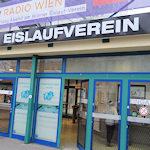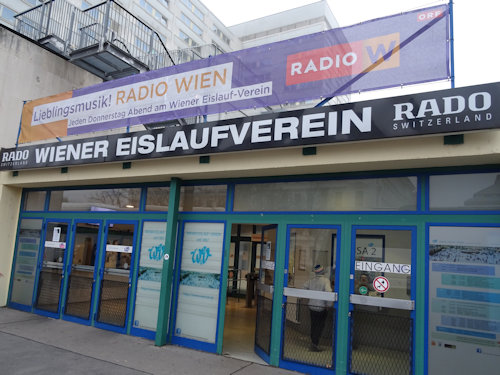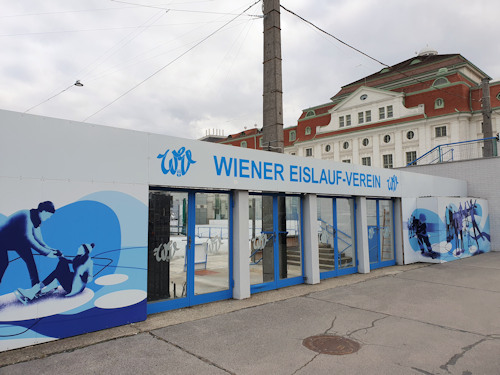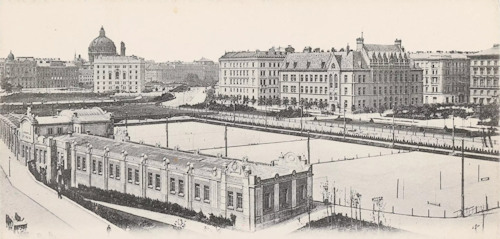
One Viennese tradition in winter is to sit around a marble coffee house tabletop with a warming coffee. Another is to turn a few circles at the open-air ice rink run by the Wiener Eislaufverein (Viennese ice skating association).
- Outdoor rink with a long, prestigious history
- Easily reached just outside the old town
- 2024/25 season began on Nov 9th
- Often hosts special events in and out of the skating season
- Book a concert experience* for your Vienna trip
- See also:
City-centre ice skating

(Modern entrance to a very traditional activity and setting)
The Eislaufverein’s rink is remarkably close to the city centre, along Lothringerstraße.
That road was named after Franz Stephan von Lothringen, the husband of Empress Maria Theresa. I don’t know if his feet ever took a turn on the ice, or if a court official once bore the title, Keeper of the Imperial Skates.
Despite its closeness to the centre, the rink’s setting is not quite as romantic as you might imagine, though the ice did play an important role in the denouement to the Sachertorte rom com.
On one side is the majesty of the famous Konzerthaus concert hall, but the opposite side is the modern Intercontinental Hotel.

(To one side of the rink you can see the Konzerthaus, opened in 1913)
The rink’s rear also looks fairly non-descript. However, the area is set to undergo significant development and the surrounds will no doubt change in the coming years.
All-in-all, then, ice skating here is more practical than fairytale, but still immensely popular with locals: tens of thousands of visitors typically twirl (or stumble) their way around the 6,000m2 of ice across the season.
The Eislaufverein itself was first established in 1867 and has a prestigious history.
For example, European, World and Olympic figure skating champions have emerged from its midst. It moved to its current home in 1901, which at one point was the largest artificial ice rink in the world.

(View over the Eislaufverein toward the Karlskirche church on a postcard from around 1900 published by Carl (Karl) Ledermann jun.; Wien Museum Inv.-Nr. 182907; excerpt reproduced with permission under the terms of the CC0 licence)
The Viennese approach to figure skating (inspired by the American skater Jackson Haines) also played an influential role in moving the sport away from the rigid (British) approach and toward the more fluid, dynamic sport we know today.
UNESCO even declared the Viennese tradition of dancing circles around the rink to music part of Austria’s official intangible cultural heritage.
Dates, tickets & tips
The 24/25 season began on November 9th (the previous winter season ended on March 10th but I don’t have confirmed end dates yet for the current season). Entrance fees at the counter typically include concessions for kids, families, etc.
Check the official website for up-to-date details on tickets, times, dates etc.
Special events & neighbours
You might actually drop in to the Eislaufverein with no intention of putting on skates or watching others pirouette their way across the ice. The location has hosted, for example, training sessions for an ATP 500 tennis tournament, an art fair, and the CEV BeachVolley Nations Cup.
The neighbouring Konzerthaus reflects the musical flavour of the wider area. A stony Beethoven, for example, stares across at the skaters from the other side of the road. (His thoughts on the choice of music played on the rink remain unknown.)
Head north for the neorenaissance Kursalon concert venue and the famous Johann Strauss statue, west for the Brahms monument on Karlsplatz and the Musikverein building (home venue for the Wiener Philharmoniker orchestra).
Getting there
Subway: U4 line to Stadtpark (take the southwest exit to the beautiful Wagner-designed station building)
Tram: D, 71 or 2 to Schwarzenbergplatz (and a short walk up past the Konzerthaus)
Bus: 4A to Akademietheater
Address: Lothringerstraße 22, 1030 Vienna